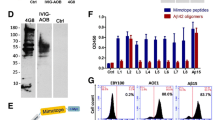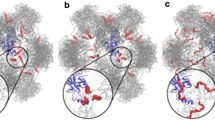Abstract
Alzheimer’s disease (AD) is the most common neurodegenerative disease, where β-amyloid (Aβ) plays a key role in forming conglomerated senile plaques. The receptor of advanced glycation end products (RAGE) is considered a therapeutic target since it transports Aβ into the central nervous system, favoring the pathology progression. Due to the lack of effective therapies for AD, several therapeutic approaches are under development, being vaccines considered a promising alternative. Herein, the use of the Algevir system was explored to produce in the Schizochytrium sp. microalga the LTB:RAGE vaccine candidate. Algevir relies in an inducible geminiviral vector and led to yields of up to 380 µg LTB:RAGE/g fresh weight biomass at 48-h post-induction. The Schizochytrium-produced LTB:RAGE vaccine retained its antigenic activity and was highly stable up to temperatures of 60 °C. These data demonstrate the potential of Schizochytrium sp. as a platform for high production of thermostable recombinant antigens useful for vaccination against AD.






Similar content being viewed by others
References
Martí, M. J., Tolosa, E., & Campdelacreu, J. (2003). Clinical overview of the synucleinopathies. Movement Disorders, 18(S6), 21–27.
Youm, J. W., Jeon, J. H., Kim, H., Kim, Y. H., Ko, K., Joung, H., et al. (2008). Transgenic tomatoes expressing human beta-amyloid for use as a vaccine against Alzheimer’s disease. Biotechnology Letters, 30, 1839–1845.
Anand, R., Gill, K. D., & Mahdi, A. A. (2014). Therapeutics of Alzheimer’s disease: Past, present and future. Neuropharmacology, 76, 27–50.
Rosales-Mendoza, S., Rubio-Infante, N., Zarazúa, S., Govea-Alonso, D., Martel-Gallegos, G., & Moreno-Fierros, L. (2014). Plant-based vaccines for Alzheimer’s disease: An overview. Expert Review of Vaccines, 13, 429–441.
Liu, B., Frost, J. L., Sun, J., Fu, H., Grimes, S., Blackburn, P., et al. (2013). MER5101, a novel Aβ1-15: DT conjugate vaccine, generates a robust anti-Aβ antibody response and attenuates Aβ pathology and cognitive deficits in APPswe/PS1ΔE9 transgenic mice. The Journal of Neuroscience, 33, 7027–7037.
Arevalo-Villalobos, J. I., Govea-Alonso, D. O., Monreal-Escalante, E., Zarazúa, S., & Rosales-Mendoza, S. (2017). LTB-Syn: A recombinant immunogen for the development of plant-made vaccines against synucleinopathies. Planta, 245(6), 1231–1239.
Yan, S. S., Chen, D., Yan, S., Guo, L., & Chen, J. X. (2012). RAGE is a key cellular target for Aβ-induced perturbation in Alzheimer’s disease. Frontiers in Bioscience (Scholar Edition), 4, 240.
Schmidt, A. M., Yan, S. D., Yan, S. F., & Stern, D. M. (2000). The biology of the receptor for advanced glycation end products and its ligands. Biochimica et Biophysica Acta, 1498(2–3), 99–111.
Webster, S. J., Mruthinti, S., Hill, W. D., Buccafusco, J. J., & Terry, A. V., Jr. (2012). An aqueous orally active vaccine targeted against a RAGE/AB complex as a novel therapeutic for Alzheimer’s disease. NeuroMolecular Medicine, 14, 119–130.
Youm, J. W., Kim, H., Han, J. H., Jang, C. H., Ha, H. J., Mook-Jung, I., et al. (2005). Transgenic potato expressing Aβ reduce Aβ burden in Alzheimer’s disease mouse model. FEBS Letters, 579, 6737–6744.
Yokoyama, R., & Honda, D. (2007). Taxonomic rearrangement of the genus Schizochytrium sensu lato based on morphology, chemotaxonomic characteristics, and 18S rRNA gene phylogeny (Thraustochytriaceae, Labyrinthulomycetes): emendation for Schizochytrium and erection of Aurantiochytrium and Oblongichytrium. Gen Nov Mycoscience, 48(4), 199–211.
Meale, S. J., Chaves, A. V., He, M. L., & McAllister, T. A. (2014). Dose—response of supplementing marine algae (Schizochytrium sp.) on production performance, fatty acid profiles, and wool parameters of growing lambs. Journal of Animal Science, 92(5), 2202–2213.
Ren, L. J., Ji, X. J., Huang, H., Qu, L., Feng, Y., Tong, Q. Q., et al. (2010). Development of a stepwise aeration control strategy for efficient docosahexaenoic acid production by Schizochytrium sp. Applied Microbiology and Biotechnology, 87(5), 1649–1656.
Bayne, A. C., Boltz, D., Owen, C., Betz, Y., Maia, G., Azadi, P., et al. (2013). Vaccination against influenza with recombinant hemagglutinin expressed by Schizochytrium sp. confers protective immunity. PLoS ONE, 8(4), e61790.
Bañuelos-Hernández, B., Monreal-Escalante, E., González-Ortega, O., Angulo, C., & Rosales-Mendoza, S. (2017). Algevir: an expression system for microalgae based on viral vectors. Frontiers on Microbiology, 8, 1100.
Romero-Maldonado, A., Monreal-Escalante, E., & Rosales-Mendoza, S. (2016). Expression in plants of two new antigens with implications in Alzheimer’s disease immunotherapy. Plant Cell, Tissue and Organ Culture (PCTOC). https://doi.org/10.1007/s11240-016-0990-9.
Neper, M., Schmidt, A. M., Brett, J., Yan, S. D., Wang, F., Pan, Y. C., et al. (1992). Cloning and expression of a cell surface receptor for advanced glycosylation end products of proteins. Journal of Biological Chemistry, 267(21), 14998–15004.
Cangelosi, G. A., Best, E. A., Martinetti, G., & Nester, E. W. (1991). Genetic analysis of Agrobacterium. Methods in Enzymology, 204, 384–397.
Dellaporta, S. L., Wood, J., & Hicks, J. B. (1983). A plant DNA minipreparation: Version II. Plant Molecular Biology Reporter, 1, 19–21.
Franklin, S., Ngo, B., Efuet, E., & Mayfield, S. P. (2002). Development of a GFP reporter gene for Chlamydomonas reinhardtii chloroplast. The Plant Journal, 30, 733–744.
Rosales-Mendoza, S., Soria-Guerra, R. E., de Jesús Olivera-Flores, M. T., López-Revilla, R., Arguello-Astorga, G. R., Jiménez-Bremont, J. F., et al. (2007). Expression of Escherichia coli heat-labile enterotoxin b subunit (LTB) in carrot (Daucus carota L.). Plant Cell Reports, 26(7), 969–976.
Gleba, Y., Marillonnet, S., & Klimyuk, V. (2014). Engineering viral expression vectors for plants: The ‘full virus’ and the ‘deconstructed virus’ strategies. Current Opinion in Plant Biology, 2, 182–188.
Rosales-Mendoza, S., Angulo, C., & Meza, B. (2016). Food-grade organisms as vaccine biofactories and oral delivery vehicles. Trends in Biotechnology, 34(2), 124–136.
Spangler, B. D. (1992). Structure and function of cholera toxin and the related Escherichia coli heat-labile enterotoxin. Microbiological Reviews, 56, 622–647.
Tochikubo, K., & Yasuda, Y. (2000). Principle of mucosal immunity and development of mucosal vaccines using cholera toxin B subunit and its related adjuvants. Recent Research Developments in Microbiology, 4, 387–405.
Acknowledgements
We acknowledge Elizabeth Monreal Escalante for providing anti-LTB serum and Sergio Zarazúa Guzman for providing anti-RAGE monoclonal antibody. Current investigations from the group are supported by CONACYT/México (Grant INFR-2016-271182 and CB-256063 to SRM) and PRODEP/UASLP México (Grant DSA/103.5/16/7283 to Benita Ortega Berlanga).
Author information
Authors and Affiliations
Corresponding author
Rights and permissions
About this article
Cite this article
Ortega-Berlanga, B., Bañuelos-Hernández, B. & Rosales-Mendoza, S. Efficient Expression of an Alzheimer’s Disease Vaccine Candidate in the Microalga Schizochytrium sp. Using the Algevir System. Mol Biotechnol 60, 362–368 (2018). https://doi.org/10.1007/s12033-018-0077-4
Published:
Issue Date:
DOI: https://doi.org/10.1007/s12033-018-0077-4




